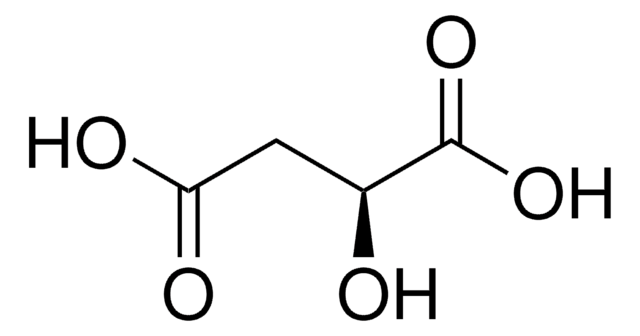G8415
Acido L-glutammico
98.5-100.5%, suitable for cell culture, non-animal source, meets EP testing specifications
Sinonimo/i:
Acido (S)-2-amminopentanodioico, Glu
About This Item
Prodotti consigliati
product name
Acido L-glutammico, from non-animal source, meets EP testing specifications, suitable for cell culture, 98.5-100.5%
Origine biologica
non-animal source
Livello qualitativo
agenzia
meets EP testing specifications
Saggio
98.5-100.5%
Forma fisica
powder
tecniche
cell culture | mammalian: suitable
Impurezze
endotoxin, tested
Colore
white
Punto di fusione
205 °C (dec.) (lit.)
Solubilità
1 M HCl: 100 mg/mL
Densità
1.54 g/cm3 at 20 °C
Anioni in tracce
chloride (Cl-): ≤200 ppm
sulfate (SO42-): ≤200 ppm
Cationi in tracce
As: ≤1 ppm, passes test
Fe: ≤10 ppm, passes test
NH4+: ≤200 ppm, passes test
applicazioni
pharmaceutical (small molecule)
Stringa SMILE
N[C@@H](CCC(O)=O)C(O)=O
InChI
1S/C5H9NO4/c6-3(5(9)10)1-2-4(7)8/h3H,1-2,6H2,(H,7,8)(H,9,10)/t3-/m0/s1
WHUUTDBJXJRKMK-VKHMYHEASA-N
Informazioni sul gene
human ... CCR2(1231) , GRIA1(2890) , GRIA2(2891) , GRIA4(2893) , GRIK1(2897) , GRIK2(2898) , GRIK3(2899) , GRIK5(2901) , GRIN2B(2904) , GRM2(2912) , SLC1A1(6505) , SLC1A2(6506)
rat ... Gria1(50592) , Grik1(29559) , Grik2(54257) , Grik4(24406) , Grin2a(24409) , Grm1(24414) , Grm2(24415) , Grm3(24416) , Grm4(24417) , Grm5(24418) , Grm6(24419) , Grm7(81672) , Slc1a2(29482)
Cerchi prodotti simili? Visita Guida al confronto tra prodotti
Categorie correlate
Applicazioni
Azioni biochim/fisiol
Applicazioni
Codice della classe di stoccaggio
11 - Combustible Solids
Classe di pericolosità dell'acqua (WGK)
WGK 1
Punto d’infiammabilità (°F)
Not applicable
Punto d’infiammabilità (°C)
Not applicable
Dispositivi di protezione individuale
Eyeshields, Gloves, type N95 (US)
Certificati d'analisi (COA)
Cerca il Certificati d'analisi (COA) digitando il numero di lotto/batch corrispondente. I numeri di lotto o di batch sono stampati sull'etichetta dei prodotti dopo la parola ‘Lotto’ o ‘Batch’.
Possiedi già questo prodotto?
I documenti relativi ai prodotti acquistati recentemente sono disponibili nell’Archivio dei documenti.
I clienti hanno visto anche
guidance
Articoli
Sigma-Aldrich presents an article about how proliferatively active cells require both a source of carbon and of nitrogen for the synthesis of macromolecules. Although a large proportion of tumor cells utilize aerobic glycolysis and shunt metabolites away from mitochondrial oxidative phosphorylation, many tumor cells exhibit increased mitochondrial activity.
Chromatograms
application for HPLCIl team dei nostri ricercatori vanta grande esperienza in tutte le aree della ricerca quali Life Science, scienza dei materiali, sintesi chimica, cromatografia, discipline analitiche, ecc..
Contatta l'Assistenza Tecnica.










